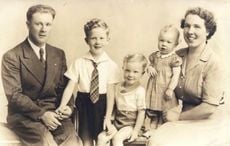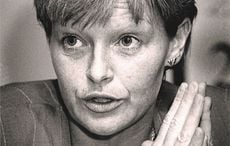When our imagination is employed it can lead to the kind of fertility that can help cement and also augment the 21st century bonds that remain very much in place between Ireland and America.
Opening this past weekend is a historical collection of archival material in various media dealing with the performing arts entitled “Ireland America: The Ties That Bind.”
The exhibit is housed at the Donald and Mary Oenslager Gallery at the New York Public Library (NYPL) for the Performing Arts on the plaza level of Lincoln Center for six months until August 13.
In the course of the larger brainstorming about the Imagine Ireland project almost three years ago, the triumvirate of Irish Cultural Ambassador Gabriel Byrne, Culture Ireland CEO Eugene Downes and NYPL Performing Arts Library executive director Jackie Davis wanted to utilize a large Lincoln Center gallery space to display many of the Irish artistic achievements in music, dance and theater at the prestigious home for cultural activity in New York City.
In conjunction with Glucksman Ireland House and NYU, they made the smart decision to detach Dr. Marion Casey, the senior archivist at the Archives of Irish America at the Bobst Library to work as curator of the project.
All of them save for Byrne, who is out of the country filming a movie, took to the high steps outside the gallery to welcome everyone to the launch on Sunday evening.
They also encouraged people to come back often and to spread the word about the collection celebrating mostly New York’s connection with the Emerald Isle through its immigrant population and its descendants. Byrne left them with an inspiring challenge. “If we aren’t going to tell our story, then who is?” recounted Casey.
Davis envisioned “something big” not for only for the Lincoln Center gallery, but in spreading out 115 events on various aspects of Irish culture throughout 87 branches and four research centers in the New York Public Library system.
Downes was excited about the idea of being able to reach out to a number of younger people as well as others around the city to show “that the traditions of Ireland and the contemporary arts were part of one continuous stream” flowing through the course of yesteryear into the present and towards the future.
While he didn’t make reference to it, he was perhaps hopeful that it would achieve success like Riverdance in boosting Ireland’s profile, and the evening was graced with one of the major stars of that iconic show, Jean Butler, the flame-haired beauty and New York native who was featured inside the gallery showing her early career up to and beyond Riverdance.
For Casey, to whom the monumental task of taking 4,000 square feet of blank gallery space to tell the history of the Irish in America for over two centuries would fall, it was a dream assignment.
As a professor at NYU in Irish American history, the number of students she would reach would pale in comparison to the countless people who will be reached through this program by the time it concludes in August.
Much of the collected material on display also reflected the unique perspective of how first and second generation Irish Americans came into contact with the Irish-born tradition bearers who left Ireland mostly out of necessity, but kept a fierce allegiance and sentimentality to the “Old Country” as my parents often referred to it.
Those close links, in particular, will diminish now with the emigration patterns and doors restricted to the Irish, and hence attention like this becomes more valuable for future generations in America.
There are a series of public programs coming up at the Lincoln Center Library for the Performing Arts on a wide variety of topics in the music and film area that would be worth attending.
On St. Patrick’s Day there are several screenings culled by the Irish Film Institute as part of a subtheme of the exhibit called “Hidden Ireland: A Celebration of Ireland in Documentary Film.” Included in that is a showing of The Ed Sullivan Show in Ireland from 1959.
I look forward to more return visits and encourage you to do also and visit the website www.nypl.org/events/exhibitions/ties-bind-irish-performing-america for a listing of activities by calendar. For a sampling of some of the oral history available at NYU Archives of Irish America, there’s a podcast available at www.irelandhouse.as.nyu.edu/object/memoriesstpatsparade.
Opening this past weekend is a historical collection of archival material in various media dealing with the performing arts entitled “Ireland America: The Ties That Bind.”
The exhibit is housed at the Donald and Mary Oenslager Gallery at the New York Public Library (NYPL) for the Performing Arts on the plaza level of Lincoln Center for six months until August 13.
In the course of the larger brainstorming about the Imagine Ireland project almost three years ago, the triumvirate of Irish Cultural Ambassador Gabriel Byrne, Culture Ireland CEO Eugene Downes and NYPL Performing Arts Library executive director Jackie Davis wanted to utilize a large Lincoln Center gallery space to display many of the Irish artistic achievements in music, dance and theater at the prestigious home for cultural activity in New York City.
In conjunction with Glucksman Ireland House and NYU, they made the smart decision to detach Dr. Marion Casey, the senior archivist at the Archives of Irish America at the Bobst Library to work as curator of the project.
All of them save for Byrne, who is out of the country filming a movie, took to the high steps outside the gallery to welcome everyone to the launch on Sunday evening.
They also encouraged people to come back often and to spread the word about the collection celebrating mostly New York’s connection with the Emerald Isle through its immigrant population and its descendants. Byrne left them with an inspiring challenge. “If we aren’t going to tell our story, then who is?” recounted Casey.
Davis envisioned “something big” not for only for the Lincoln Center gallery, but in spreading out 115 events on various aspects of Irish culture throughout 87 branches and four research centers in the New York Public Library system.
Downes was excited about the idea of being able to reach out to a number of younger people as well as others around the city to show “that the traditions of Ireland and the contemporary arts were part of one continuous stream” flowing through the course of yesteryear into the present and towards the future.
While he didn’t make reference to it, he was perhaps hopeful that it would achieve success like Riverdance in boosting Ireland’s profile, and the evening was graced with one of the major stars of that iconic show, Jean Butler, the flame-haired beauty and New York native who was featured inside the gallery showing her early career up to and beyond Riverdance.
For Casey, to whom the monumental task of taking 4,000 square feet of blank gallery space to tell the history of the Irish in America for over two centuries would fall, it was a dream assignment.
As a professor at NYU in Irish American history, the number of students she would reach would pale in comparison to the countless people who will be reached through this program by the time it concludes in August.
Much of the collected material on display also reflected the unique perspective of how first and second generation Irish Americans came into contact with the Irish-born tradition bearers who left Ireland mostly out of necessity, but kept a fierce allegiance and sentimentality to the “Old Country” as my parents often referred to it.
Those close links, in particular, will diminish now with the emigration patterns and doors restricted to the Irish, and hence attention like this becomes more valuable for future generations in America.
There are a series of public programs coming up at the Lincoln Center Library for the Performing Arts on a wide variety of topics in the music and film area that would be worth attending.
On St. Patrick’s Day there are several screenings culled by the Irish Film Institute as part of a subtheme of the exhibit called “Hidden Ireland: A Celebration of Ireland in Documentary Film.” Included in that is a showing of The Ed Sullivan Show in Ireland from 1959.
I look forward to more return visits and encourage you to do also and visit the website www.nypl.org/events/exhibitions/ties-bind-irish-performing-america for a listing of activities by calendar. For a sampling of some of the oral history available at NYU Archives of Irish America, there’s a podcast available at www.irelandhouse.as.nyu.edu/object/memoriesstpatsparade.




Comments